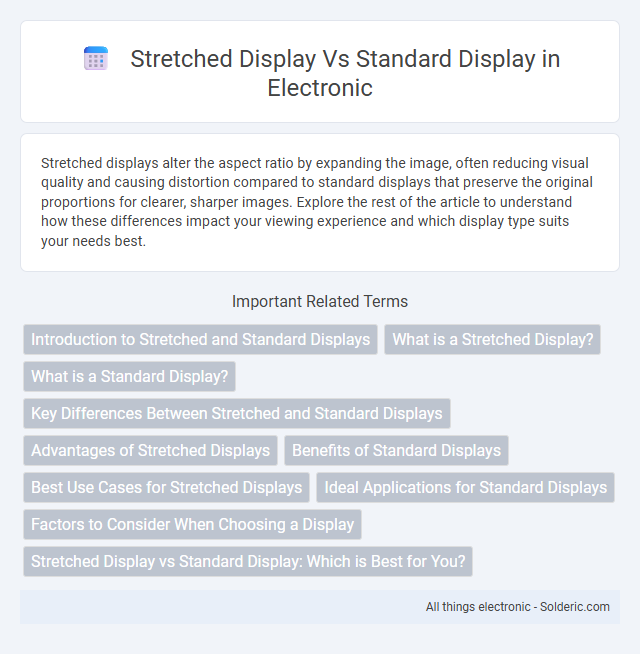Stretched displays alter the aspect ratio by expanding the image, often reducing visual quality and causing distortion compared to standard displays that preserve the original proportions for clearer, sharper images. Explore the rest of the article to understand how these differences impact your viewing experience and which display type suits your needs best.
Comparison Table
| Feature | Stretched Display | Standard Display |
|---|---|---|
| Aspect Ratio | Non-standard, elongated | Standard ratios (16:9, 4:3) |
| Image Quality | Potential distortion, pixel stretching | Optimal clarity, true proportions |
| Use Case | Wider viewing area for panoramic content | General purpose, media consumption |
| Compatibility | Limited support by some apps and games | Universal support |
| Visual Experience | Can feel unnatural or stretched | Natural, intended display ratio |
| Price | Often more expensive due to custom design | Generally affordable and widely available |
Introduction to Stretched and Standard Displays
Stretched displays feature an extended aspect ratio, tailored for wider or unconventional screen formats, enhancing visual workspace and immersive experiences. Standard displays maintain a traditional 16:9 or 4:3 aspect ratio, offering consistent compatibility with most media and applications. Understanding your specific needs helps determine whether a stretched or standard display best supports Your productivity and viewing preferences.
What is a Stretched Display?
A stretched display refers to a screen format that expands the standard aspect ratio to fit wider spaces, often used in digital signage and advertising to maximize visible content across non-traditional or elongated screen dimensions. This type of display enhances visual engagement by delivering content that adapts seamlessly to unique architectural layouts, providing higher impact and better utilization of available display area. Unlike standard displays with fixed aspect ratios like 16:9, stretched displays often use ratios such as 32:9 or custom sizes, offering flexibility for creative and dynamic content presentation.
What is a Standard Display?
A Standard Display refers to a conventional screen size and aspect ratio commonly used in most monitors, laptops, and televisions, typically featuring resolutions such as 1920x1080 (Full HD) or 1366x768. It offers balanced image quality and compatibility with a wide range of software applications and multimedia content without distortion. Standard Displays maintain consistent pixel density and color accuracy, making them ideal for everyday computing, gaming, and video playback.
Key Differences Between Stretched and Standard Displays
Stretched displays feature an extended aspect ratio that offers a wider viewing area compared to standard displays, which typically maintain a 16:9 ratio. Key differences include improved visibility for information-dense content on stretched displays, making them ideal for digital signage and control rooms, while standard displays prioritize balanced visuals for general multimedia consumption. Resolution and pixel density vary, with stretched displays often tailored for specialized applications requiring panoramic display layouts.
Advantages of Stretched Displays
Stretched displays offer enhanced visibility and increased screen real estate by extending content across wider surfaces, ideal for digital signage and public information systems. They provide higher viewer engagement through panoramic and immersive visual experiences, improving message retention in retail, transportation hubs, and control rooms. These displays optimize space utilization by fitting unconventional areas, delivering cost-effective solutions without compromising image quality or resolution.
Benefits of Standard Displays
Standard displays offer superior color accuracy and consistent image quality, making them ideal for professional design and media applications. Their widespread compatibility with various devices and software ensures seamless integration in both personal and business environments. The reliable resolution and refresh rates of standard displays provide a balanced visual experience suitable for everyday tasks and high-definition content consumption.
Best Use Cases for Stretched Displays
Stretched displays excel in environments requiring wide visibility such as retail storefronts, control rooms, and event venues where panoramic or widescreen content engages viewers more effectively. Their extended aspect ratio allows for enhanced multitasking, real-time monitoring, and immersive advertising by presenting continuous information across a larger horizontal space. Choosing a stretched display for your setup ensures optimal content presentation in scenarios demanding expansive, high-impact visual communication.
Ideal Applications for Standard Displays
Standard displays are ideal for applications requiring accurate color reproduction and consistent image quality, such as graphic design, video editing, and office work. They excel in environments where standard aspect ratios (16:9 or 4:3) are essential for compatibility with most software and media content. Your workspace benefits from the reliable performance and widespread support provided by standard displays in everyday computing tasks.
Factors to Consider When Choosing a Display
When choosing between a stretched display and a standard display, consider screen resolution, aspect ratio, and intended application, as stretched displays offer wider viewing areas suitable for digital signage and immersive environments. Evaluate the compatibility with existing hardware and software to ensure seamless integration and optimal performance. Additionally, assess the cost implications, installation space requirements, and maintenance needs specific to each display type for a cost-effective and efficient solution.
Stretched Display vs Standard Display: Which is Best for You?
Stretched displays offer a wider aspect ratio, enhancing the field of view in gaming and financial trading, while standard displays provide consistent image quality and compatibility for general use and multimedia. Users prioritizing immersive experiences or multitasking benefit from stretched displays, whereas those requiring color accuracy and uniform resolution may prefer standard displays. Choosing between them depends on whether wider visuals or classic display fidelity aligns better with your specific tasks and preferences.
Stretched Display vs Standard Display Infographic

 solderic.com
solderic.com